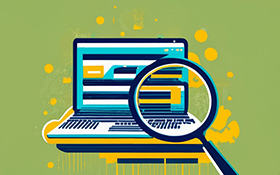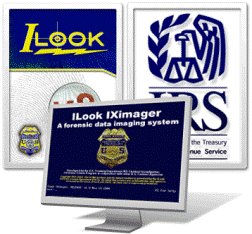
ILook Investigator Computer Forensics Software
![]()
|
|
||||||

IRS-CI Electronic Crimes
|
A Deep Dive into Computer Forensic Tools |
|
|
|
 Computer forensics stands as a paramount domain within cybersecurity, instrumental in navigating the intricate maze of contemporary digital investigations. This discipline delves into the rigorous examination of electronic data, with its primary objective being the preservation, retrieval, analysis, and presentation of facts and opinions about the information amassed.
Computer forensics stands as a paramount domain within cybersecurity, instrumental in navigating the intricate maze of contemporary digital investigations. This discipline delves into the rigorous examination of electronic data, with its primary objective being the preservation, retrieval, analysis, and presentation of facts and opinions about the information amassed.
Computer forensics delineates the methodical collection, analysis, and reporting of digital data in a manner that is legally defensible. It finds its application in the detection and prevention of crimes and in any dispute where evidence resides in a digital format.
In an epoch where cybercrimes are surging at an unparalleled pace, computer forensics emerges as an essential discipline, aiding in the identification, tracking, and prosecution of cyber malefactors. It offers a structured approach to unearth digital evidence, ensuring the data's integrity and reliability, while maintaining an unbroken chain of custody, a prerequisite in legal scenarios.
Key Concepts in Computer Forensics
Data Recovery
Data recovery, a linchpin in computer forensics, revolves around the meticulous extraction of data from diverse storage mediums, ensuring the sanctity of the original data during the retrieval process. Leveraging a plethora of tools and methodologies, forensic specialists recover data that might have been deleted, encrypted, or otherwise obscured. Techniques such as file carving, live memory forensics, and database forensics are indispensable in affirming the recovered data's suitability for subsequent analysis and legal adjudication.
Cybersecurity
Within the realm of cybersecurity, computer forensics acts as a bulwark against cyber onslaughts, facilitating the post-mortem dissection of cyber incursions, pinpointing exploited vulnerabilities, and tracing the tactics of cyber adversaries. Insights derived from forensic evaluations shape cybersecurity protocols, bolstering defenses and preempting future assaults.
Data Breach and Privacy Violations Investigations
Computer forensics is pivotal in probing data breaches and privacy infringements, decoding the magnitude of data compromise, discerning exploited vulnerabilities, and gauging the ramifications of the breach on impacted entities. Forensic connoisseurs dissect compromised systems, trace data exfiltration trajectories, and play a role in alerting the affected stakeholders, thus aiding in regulatory adherence and curtailing reputational fallout.
Network Intrusion Detection and Analysis
Computer forensics is harnessed to detect and dissect network intrusions, pinpointing unauthorized incursions and curtailing potential damage to the network fabric. Forensic maestros pore over network logs, evaluate traffic dynamics, and spot anomalies, ensuring the triad of network integrity, confidentiality, and availability remains inviolate.
Malware Analysis
In the milieu of malware analysis, computer forensics empowers experts to anatomize malware, fathom its modus operandi, dissemination mechanisms, and repercussions on compromised systems. Forensic scrutiny of malware is instrumental in crafting detection signatures, discerning the malware's intent, and instituting countermeasures to neutralize its effects and avert subsequent infiltrations.
Mobile Forensics
Mobile forensics zeroes in on the extraction and evaluation of data such as messages, images, videos, audio files, and contacts from mobile apparatuses. This domain is paramount in investigating a spectrum of malefactions, encompassing cyberbullying, online intimidation, and unauthorized data access, ensuring malefactors exploiting mobile ecosystems face retribution.
Computer Forensics Tools
Computer forensics, a niche specialization, concentrates on the amassment and dissection of digital evidence from a gamut of digital media platforms, spanning desktops, mobile gadgets, cloud paradigms, and IoT devices. This evidence can be pivotal for incident redress or legal adjudications. Given the eclectic nature of digital platforms and the myriad data types they harbor, a vast array of tools is at the disposal of forensic experts, each tailored for specific tasks within the forensic investigative continuum. Here's an exhaustive overview of some of the most salient tools in this domain:
Disk Analysis: Autopsy/The Sleuth Kit
Description: Autopsy and The Sleuth Kit rank among the most venerated forensic toolkits. While The Sleuth Kit operates as a command-line tool, dissecting forensic images of hard drives and smartphones, Autopsy offers a graphical interface, harnessing The Sleuth Kit's capabilities.
Features: They boast a modular and extensible architecture, permitting users to augment functionalities. Both are open-source, but commercial support and training avenues exist.
Image Creation: FTK Imager
Description: Tools like Autopsy and The Sleuth Kit, while adept at analyzing disk images, don't fabricate them. FTK Imager bridges this chasm, facilitating the creation of disk images and ensuring the sanctity of the original drive during the forensic endeavor.
Features: An integral component of the AccessData Forensics Toolkit, FTK Imager is a gratis tool.
Memory Forensics: Volatility
Description: Volatility stands out as a preeminent tool for the analysis of volatile memory (RAM). Given that RAM can be a repository of pivotal forensic data, its swift and precise capture is imperative.
Features: Volatility, an open-source marvel, welcomes third-party plugins. The Volatility Foundation even orchestrates an annual contest to crown the best plugin development.
Windows Registry Analysis: Registry Recon
Description: The Windows registry, a treasure trove of data about the OS and resident applications, is the forte of Registry Recon, which specializes in its analysis and can even resurrect deleted segments from unallocated memory realms.
Features: It's a proprietary tool, tailored to reconstruct registries from forensic images.
Mobile Forensics: Cellebrite UFED
Description: Given the omnipresence of mobile devices, mobile forensics has burgeoned into an indispensable domain. Cellebrite UFED stands as a premier commercial tool for this endeavor.
Features: It is versatile, supporting a plethora of platforms and proffering exclusive methodologies for mobile device scrutiny.
Network Analysis: Wireshark
Description: Wireshark, the quintessential tool for network traffic analysis, offers a lens into cyber-attacks and other network activities.
Features: It's gratis, open-source, and can parse a plethora of network traffic types. It supports real-time traffic capture and can dissect archived network capture files.
Browser Analysis: DumpZilla
Description: DumpZilla, tailored for browser forensics, predominantly targets Firefox, Iceweasel, and Seamonkey clients.
Features: It renders and extracts a plethora of data, including cookies, downloads, history, bookmarks, cache, add-ons, saved credentials, and session data.
Linux Distributions: CAINE (Computer Aided Investigative Environment)
Description: CAINE is a Linux distribution, custom-crafted for digital forensics. It comes preloaded with forensic tools, obviating the need for investigators to set them up.
Features: It encompasses numerous popular computer forensics tools and might support third-party plugins for tools like Autopsy.
Future of Computer Forensics
The trajectory of computer forensics is inexorably tethered to nascent technologies. The amalgamation of Artificial Intelligence (AI) and Machine Learning (ML) into forensic methodologies promises to amplify data analysis capabilities, automating pattern and anomaly detection, and expediting the analysis of voluminous datasets. Moreover, the advent of Blockchain technology augurs well for data integrity, offering a verifiable and immutable ledger of digital transactions.
The horizon also portends a surge in the intricacy of cyber threats. The proliferation of IoT devices, juxtaposed with advancements in cyber-attack stratagems, mandates a ceaseless evolution of forensic practices. The future tapestry of computer forensics will be painted by a relentless tussle against evolving cyber threats, necessitating the genesis of avant-garde strategies and tools to shield digital domains.
The Evolving Landscape of Computer Forensics
The multifarious realm of computer forensics, while pivotal in charting the convoluted digital terrain, is in perpetual flux, necessitating adaptive stratagems to counter the complexities ushered in by technological innovations and burgeoning cyber threats. The rigorous extraction, dissection, and presentation of digital evidence, while adhering to ethical tenets and legal scaffolds, remain paramount in fortifying digital ecosystems and championing justice. As we embark on future journeys, the synergy between computer forensics and emergent technologies will be vital in bolstering capabilities, thwarting threats, and ensuring the pertinence and efficacy of forensic practices in the digital cosmos.
|
© Copyright 2006. ilook-forensics.org |
|

